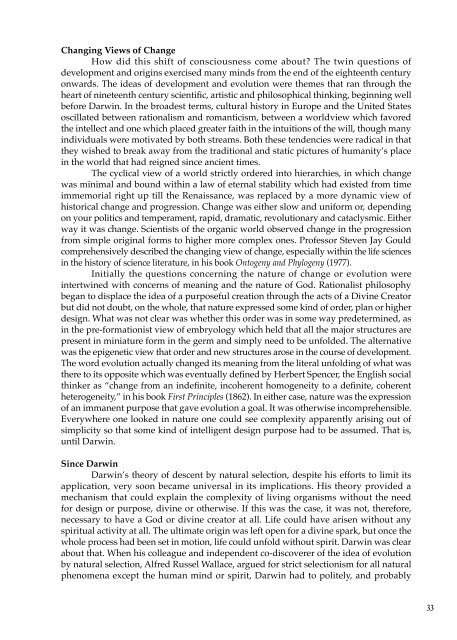The Spirit in Human Evolution - Waldorf Research Institute
The Spirit in Human Evolution - Waldorf Research Institute
The Spirit in Human Evolution - Waldorf Research Institute
You also want an ePaper? Increase the reach of your titles
YUMPU automatically turns print PDFs into web optimized ePapers that Google loves.
Chang<strong>in</strong>g Views of Change<br />
How did this shift of consciousness come about? <strong>The</strong> tw<strong>in</strong> questions of<br />
development and orig<strong>in</strong>s exercised many m<strong>in</strong>ds from the end of the eighteenth century<br />
onwards. <strong>The</strong> ideas of development and evolution were themes that ran through the<br />
heart of n<strong>in</strong>eteenth century scientific, artistic and philosophical th<strong>in</strong>k<strong>in</strong>g, beg<strong>in</strong>n<strong>in</strong>g well<br />
before Darw<strong>in</strong>. In the broadest terms, cultural history <strong>in</strong> Europe and the United States<br />
oscillated between rationalism and romanticism, between a worldview which favored<br />
the <strong>in</strong>tellect and one which placed greater faith <strong>in</strong> the <strong>in</strong>tuitions of the will, though many<br />
<strong>in</strong>dividuals were motivated by both streams. Both these tendencies were radical <strong>in</strong> that<br />
they wished to break away from the traditional and static pictures of humanity’s place<br />
<strong>in</strong> the world that had reigned s<strong>in</strong>ce ancient times.<br />
<strong>The</strong> cyclical view of a world strictly ordered <strong>in</strong>to hierarchies, <strong>in</strong> which change<br />
was m<strong>in</strong>imal and bound with<strong>in</strong> a law of eternal stability which had existed from time<br />
immemorial right up till the Renaissance, was replaced by a more dynamic view of<br />
historical change and progression. Change was either slow and uniform or, depend<strong>in</strong>g<br />
on your politics and temperament, rapid, dramatic, revolutionary and cataclysmic. Either<br />
way it was change. Scientists of the organic world observed change <strong>in</strong> the progression<br />
from simple orig<strong>in</strong>al forms to higher more complex ones. Professor Steven Jay Gould<br />
comprehensively described the chang<strong>in</strong>g view of change, especially with<strong>in</strong> the life sciences<br />
<strong>in</strong> the history of science literature, <strong>in</strong> his book Ontogeny and Phylogeny (1977).<br />
Initially the questions concern<strong>in</strong>g the nature of change or evolution were<br />
<strong>in</strong>tertw<strong>in</strong>ed with concerns of mean<strong>in</strong>g and the nature of God. Rationalist philosophy<br />
began to displace the idea of a purposeful creation through the acts of a Div<strong>in</strong>e Creator<br />
but did not doubt, on the whole, that nature expressed some k<strong>in</strong>d of order, plan or higher<br />
design. What was not clear was whether this order was <strong>in</strong> some way predeterm<strong>in</strong>ed, as<br />
<strong>in</strong> the pre-formationist view of embryology which held that all the major structures are<br />
present <strong>in</strong> m<strong>in</strong>iature form <strong>in</strong> the germ and simply need to be unfolded. <strong>The</strong> alternative<br />
was the epigenetic view that order and new structures arose <strong>in</strong> the course of development.<br />
<strong>The</strong> word evolution actually changed its mean<strong>in</strong>g from the literal unfold<strong>in</strong>g of what was<br />
there to its opposite which was eventually def<strong>in</strong>ed by Herbert Spencer, the English social<br />
th<strong>in</strong>ker as “change from an <strong>in</strong>def<strong>in</strong>ite, <strong>in</strong>coherent homogeneity to a def<strong>in</strong>ite, coherent<br />
heterogeneity,” <strong>in</strong> his book First Pr<strong>in</strong>ciples (1862). In either case, nature was the expression<br />
of an immanent purpose that gave evolution a goal. It was otherwise <strong>in</strong>comprehensible.<br />
Everywhere one looked <strong>in</strong> nature one could see complexity apparently aris<strong>in</strong>g out of<br />
simplicity so that some k<strong>in</strong>d of <strong>in</strong>telligent design purpose had to be assumed. That is,<br />
until Darw<strong>in</strong>.<br />
S<strong>in</strong>ce Darw<strong>in</strong><br />
Darw<strong>in</strong>’s theory of descent by natural selection, despite his efforts to limit its<br />
application, very soon became universal <strong>in</strong> its implications. His theory provided a<br />
mechanism that could expla<strong>in</strong> the complexity of liv<strong>in</strong>g organisms without the need<br />
for design or purpose, div<strong>in</strong>e or otherwise. If this was the case, it was not, therefore,<br />
necessary to have a God or div<strong>in</strong>e creator at all. Life could have arisen without any<br />
spiritual activity at all. <strong>The</strong> ultimate orig<strong>in</strong> was left open for a div<strong>in</strong>e spark, but once the<br />
whole process had been set <strong>in</strong> motion, life could unfold without spirit. Darw<strong>in</strong> was clear<br />
about that. When his colleague and <strong>in</strong>dependent co-discoverer of the idea of evolution<br />
by natural selection, Alfred Russel Wallace, argued for strict selectionism for all natural<br />
phenomena except the human m<strong>in</strong>d or spirit, Darw<strong>in</strong> had to politely, and probably<br />
33
















